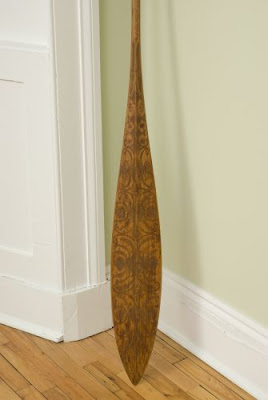I've had to accept the fact that I've run out of time to complete the bark canoe this season. With the birth of the little one, my immediate priorites have obviously changed. With one last trip up to cottage before winter set it, I prepped the incomplete canoe for storage.

I was really concerned about whether all my work on the bark canoe to this point would be ruined if a stitched, unsupported hull was left to sit in a barely heated garage over the winter. None of the readings I had come across mentioned builders who made their boat over two paddling seasons. That is until I came across an article in
Wooden Canoe (Edition 43: 1990, pp.3-9) written by James Dina previewing his now out of print book,
Voyage of the Ant. The article was fantastic especially given that Dina also built his own birchbark canoe (an 11 footer like mine) but did so with extreme devotion to the craft - using only stone age, pre-European contact tools the natives would have used. His article discusses stone axes, bow drills, flint carving knives, etc. Given that he was working alone as well, the hull wasn't finished over the summer season so had to let his canoe "hibernate" over the winter...in his case leaving it outdoors though protected from the elements with tree coverage, etc. The key point I gathered from his article was the use of temporary ribs to strengthen the hull during the slumber, so I set out to bend some for my boat.
While I respect Dina's dedication to authenticity, I was willing to use some modern equipment to get the job done. In my case, I wanted to use whatever scraps and free stuff I could get of off
Toronto's Craigslist. With a 5 ft long piece of discarded PVC pipe (ABS would've been better but no luck), some 3/8" dowels, wood scrap supports, plastic tubing, a kettle and a hot plate, I rigged up a steaming chamber for bending some temporary ribs.



Setting ut a steaming tube with scraps

The rig set up outdoorsI fashioned a few ribs and sheathing out of some scrap red cedar lying around and after an overnight soak in the lake, the ribs were put into the steaming tube for 20 minutes. PVC has a tendency to soften and sag with heat, but I made sure it was well supported and it held its shape. The exterior & interior of the bark hull were thoroughly softened with some boiling water and temporary sheathing layed. The ribs were placed in 3 positions (basically under the thwarts) and were pressed into place with vertical struts jammed under the temporary thwarts. Once finished, the hull stiffened up nicely.


Stiffened hull ready for winter slumberThis temporary stretching of the bark has added some needed rigidity to the hull and although it looks quite rounded (and extremely unstable) at the moment, I'm confident that the hull will flatten out when the bark is softened again in the spring and the real ribs are bent into place. Here's the final shot of the bark canoe resting and packed away for the season (found space above my blue, fiberglass canoe, Marge).

Hibernating Bark CanoeOver the winter months, I plan to finish off carving the necessary parts of the boat - the ribs, sheathing, gunwale caps, etc. if I get any free time.







































 The Canadian Canoe Museum has updated their
The Canadian Canoe Museum has updated their 



